Bayer R.G. Mechanical Wear Fundamentals and Testing, Revised and Expanded
Подождите немного. Документ загружается.


Such modes are possible, since stress levels decrease with wear with a ball–plane
geometry. Values less than 0.5 can also imply that a transition to a milder mode of wear
isoccurringasshowninFig.9.44
. Interpretation of the wear curves in this fashion can
then be used as a basis for predicting absolute wear behavior in an application and
providing some element of acceleration to the wear test. For such uses it might be
necessary to convert Eq. (9.7) to the equivalent one for wear volume by using the
appropriate geometrical relationship between depth and volume.
Obviously the same type of approach can be applied to other wear tests, like the pin-
on-disk or the block-on-ring. Wear on the counterface has to be taken into account with
this approach as well. This might require the use of two wear curves to characterize the
system, which can complicate the evaluation and extension to an application. However,
in many cases, the wear on one member is negligible or it might be possible to adjust
the test situation so that this is the case. In both the pin-on-disk and the ball-on-plane
tests, the relative wear can be changed by adjusting such factors as load, amplitude of
motion, and location of the materials in the wear test. The occurrence of significant wear
on the counterface at some point during the test might result in transition in the wear
behavior of the primary surface. The use of this type of approach is illustrated in the dis-
cussions of other tests and case studies in EDW2E.
In the discussions of the three sliding tests, which utilize initial nonconforming
contacts, the comment has been made that the wear curves are typically nonlinear.
The general reason proposed for this nonlinear behavior is the modification of the
contact geometry with wear and, more specifically, the variation in stress level with wear.
On the one hand, this is a complicating feature of the test, as has been mentioned in the
discussions of these tests. On the other hand, these tests provide a means of investigating
the sensitivity of wear to these parameters. A test geometry, in which the geometry of
the contact or the stress level does not change, such as a thrust washer configuration or
a rectangular block on a flat, would miss such factors. For example, the variable and
constant energy wear modes that have been observed with a ball–plane test would not have
been evident in the conforming tests (24,37). While simulation might require the use of
conforming and constant area configurations, the nonconforming tests tend to provide a
much more complete valuat ion of wear behavior because of these sensitivities.
Figure 9.44 The effect of a transition to a milder mode of wear on the apparent exponent. The
solid curve represents the best fit of all the data. The dashed curves show a piece-wise fit of the same
data, assuming a transition in wear behavior.
Copyright 2004 by Marcel Dekker, Inc. All Rights Reserved.
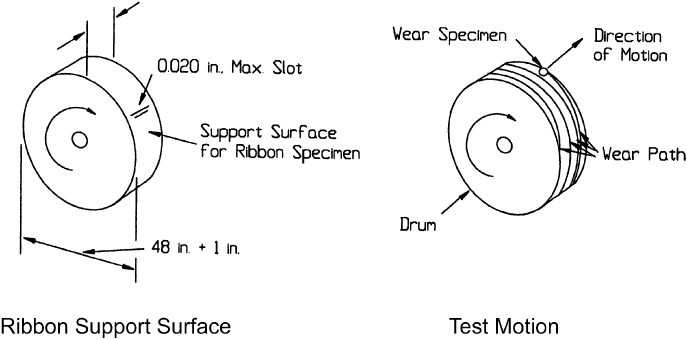
9.2.12. Drum Wear Test
ThetestapparatusforthistestisshowninFig.9.45
. This test was developed to address
wear problems associated with such materials as papers, printer ribbons, and tapes
(38–40). These materials tend to be abrasive and can wear hard, wear-resistant materials
(e.g., hardened steel, tungsten carbide, and diamond). At the same time, the wear resis-
tance of these materials is very low in compari son to that of the counterface materials
used in most applications. The use of more conventional test configurations (such as
pin-on-disk or block-on-ring, in which one of the members could accommodate the
mounting of paper, tape, or ribbon samples) generally results in little wear of the wear
specimen but significant wear of the tape, ribbon, or paper specimen. In addition to this,
the abrasivity of these materials tends to decrease with wear. As a result, it is generally not
possible with these types of tests to either determine the wear resistance of the counterface
or to get an accurate measure of the abrasivity of the paper, tape, or ribbon. Furthermore,
in many of the applications, it is the cou nterface which experiences significant wear
and the paper, ribbon or tape experiences minor wear. Consequently, common and
conventional test configurations do not provide good simulation. The drum test apparatus
was designed and the test method developed to provide a large amount of surface area of
the paper, ribbon, or tape, against a relatively small amount of wear area for the wear
specimen and to provide simulation in terms of loads, speeds, and relative wear.
While this apparatus was developed to specifically address wear between magnetic
heads and paper imprinted with magnetic characters and ba r code, it can be used with
any web-like materials. This apparatus, like the slurry abrasivity apparatus, can be used
either to determine the abrasivity of materials or to determine the wear resistance of mate-
rials to this type of wear. Several examples of its use are discussed in the literat ure and test
results have been found to correlate with a variety of applications (e.g., wear of magnetic
heads, type surfaces in printers, punches, and guiding surfaces for papers, ribbons, and
tapes)(39–43).
A standard test procedure (ASTM G56) has also been established with
this apparatus to characterize the abrasivity of printer ribbons. While details of the test
procedures associated with these applications do vary, there are some common features
and elements. A review of the procedures in ASTM G56 serves to identify most of
these.
Figure 9.45 Basic configuration of the drum wear test for web material.
Copyright 2004 by Marcel Dekker, Inc. All Rights Reserved.
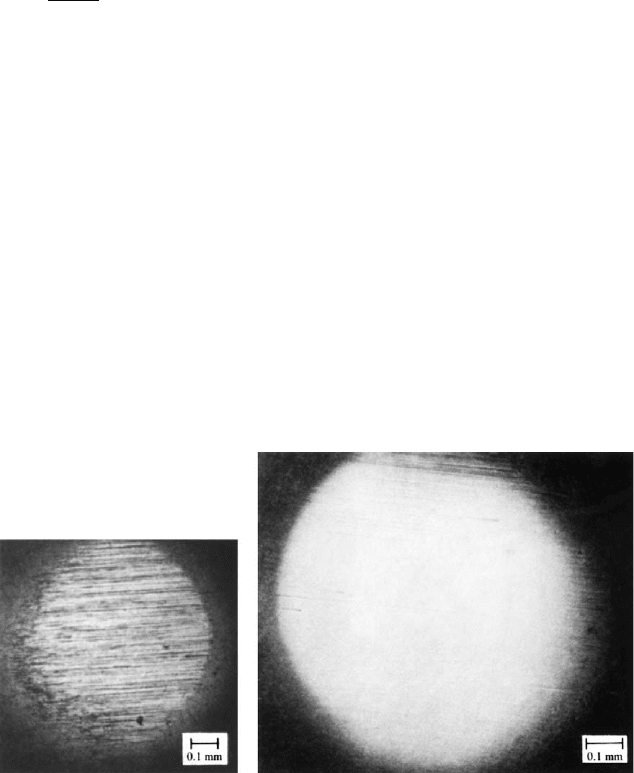
In this type of wear test, the ribbon or other web material is wrapped around the
periphery of the drum and the wear specimen is loaded against the wra pped surface of
the drum. As the drum rotates, the wear specimen moves across the surface of the drum
in an axial direction. The resultant wear path on the surface of the drum is a helix. The
values of the load, rotational speed, and cross-feed speed of the specimen, as well as
the shape of the wear specimen, can be varied to provide simulation. These parameters
also influence the wear behavior in the test. For the standard test to determine ribbon
abrasivity studies were performed to investigate the influence of these parameters on the
wear and specific values were selected for the standard.
To de termine ribbon abrasivity, a 52100 hardened steel sphere is used as the wear
specimen. The abrasivity of the ribbon is quantified in terms of a wear coefficient, K, which
is given by the following equation:
K ¼
V p
P S
ð9:8Þ
where V is the volume of the wear pro duced on the sphere after a sliding amo unt, S,
under a normal load of P. p is the penetration hardness of the 52100 steel . The higher
the value of K, the more abrasive the ribbon is. A specific duration for the test is not
specified and can be varied, provided the amount of sliding is sufficient to produce a
sufficiently large flat spot on the wear specimen. Examples of typical wear scars gene-
ratedinthistestareshowninFig.9.46
. The wear scars are not always perfectly flat
and round. There is typically some rounding of the edges of the wear scar and the scar
tends to be elongated in the direction of sliding, particularly for small amounts of wear.
The volume of wear can be determined by any method but the standard method uses a
profilometer technique that involves comparing initial and worn traces in two orthogonal
directions. One set of measurements is taken in the direction parallel to the sliding; the
other, perpendicular to the sliding. Using data obtained from these comparisons,
the wear volume is calculated by means of the equations provided, which are based on
the geometry of the specimens and wear scars. One technique for comparing the unworn
andworntracesandtheequationsusedtodeterminevolumeareshowninFig.9.47
.
Figure 9.46 Examples of wear scars produced on steel surfaces by printer ribbons, using the drum
test. (From Ref. 120.)
Copyright 2004 by Marcel Dekker, Inc. All Rights Reserved.
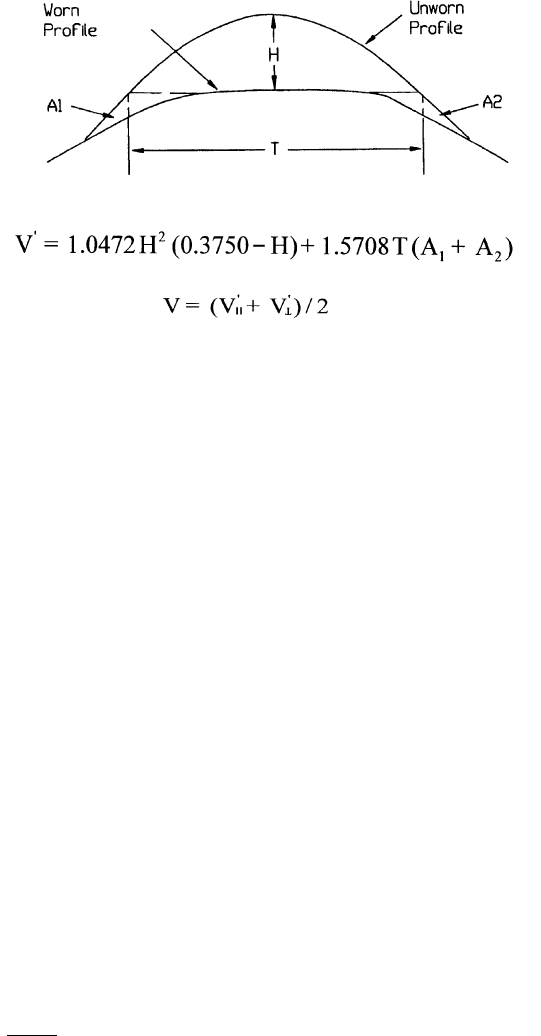
It can be seen that this method allows for wear scars that are not perfectly flat. The wear
volumes determined from the two orthogonal measurements are averaged to account for
noncircular wear scars.
The coefficient of variation for K that has been obtained with this method is in the
range 5–25%.
While K has the form of an abrasive wear coefficient that is independent of the
abradedmaterial(e.g.,Eq.(3.95)),itisnotcompletelyindependent.
As discussed in
the section on abrasive wear, 3.8, the wear of a material can be influenced by its relative
hardness to that of the abrasive. The wear is much less if the abraded surface is harder
than the abrasive. Ribbons and inks can contain particles of different hardness. Conse-
quently, while the abrasion by softer abrasives may be negligible with a hard specimen,
it may be significant with a softer specimen. In addition since there is the potential for
corrosion with ink ribbon, chemical aspect of the wear processes can be different for dif-
ferent materials, making K material sensitive. Consequently, the standard test does not
provide an absolute measure of the effective abrasivity of the ribbon but a general rank-
ing of the ribbons. Slight variations in ranking would be anticipated with the use of a
different wear specimen. Hardened 52100 steel spheres were chosen for the standard
specimen since they are easily obtainable with good control of size, composition, and
hardness. Furthermore, the hardness is representative of many of the materials used
in the applications and chemically it is not unique or particularly unusual.
To account for this potential variability and to determine an abrasive coefficient for
different ribbon and mate rial combinations, tests with other materials are performed.
When this is done , another wear coefficient, K
0
, is used. K
0
is given by
K
0
¼
V
P S
ð9:9Þ
ValuesofK
0
obtained52100andstainlesssteelspecimensareshowninTable9.2a, along
with K values for these ribbons. These show some variation in the relative rankings. Since
stainless steels tend to be more corrosive resistant, the primary difference in K
0
values and
rankings obtained with these two material is attributed to oxidative effects. This is
Figure 9.47 Method for determining wear volume on spheres using a profilometer overlay tech-
nique. V
0
is the volume obtained from a single trace. V is the average volume used for determining
the wear coefficient. (From Ref. 112.)
Copyright 2004 by Marcel Dekker, Inc. All Rights Reserved.
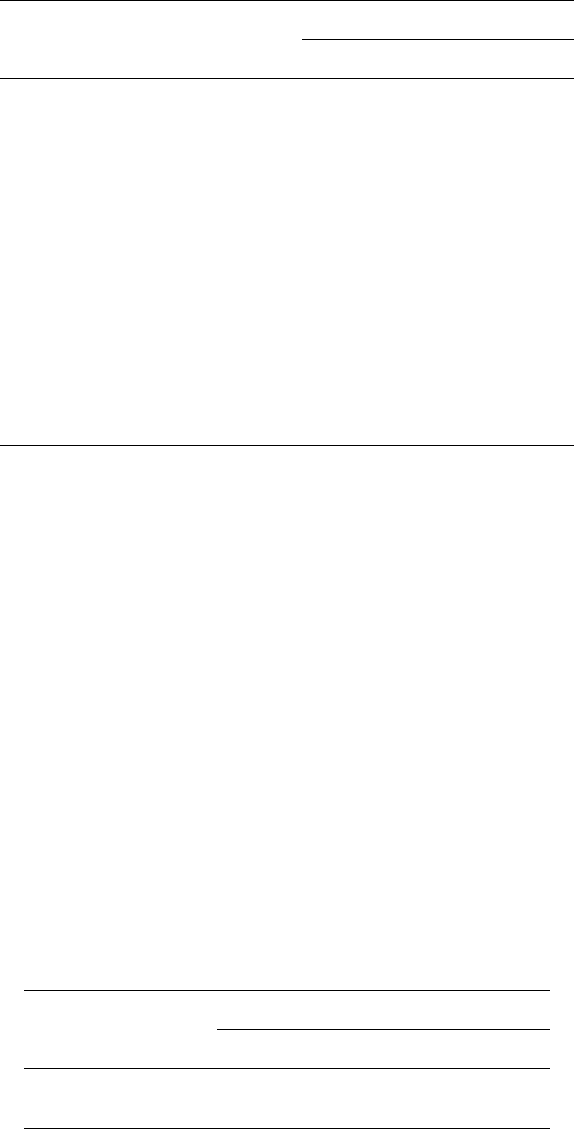
supported by the similar values obtained for K
0
when they are tested in a noncorrosive
abrasivesituation(Table9.2b). K
0
can be viewed as a coefficient in a linear equation
for abrasive wear,
V ¼ K
0
P S ð9:10Þ
K
0
is the abrasive coefficient for the particular ribbon=material pair tested and has the
dimensions of volume=load-distance. In this context, the test provides an absolute measure
of abrasion resistance or abrasivity and can be used to predict wear in applications
utilizing that pair.
In selecting the parameters for this type of test, a major factor is the amount of
damage or wear that is produced on the web material. Obviously the load, speed, and
shapeoftheslidershouldbesuchthattheabrasivemediaisnottorn
or otherwise
damaged in a macroscopic way. Beyond this there is the additional concern with micro-
scopic damage or changes that can occur and influence the abrasivity of the ribbon, tape,
or paper being tested. A general feature of these materials is that their abrasivity changes
with use (39). For example repeated tests on the same ribbon specimen, utilizing the para-
meters of ASTM G56, show a significant decrease in K values. A factor of 1=2 is usually
Table 9.2a K and K
0
Values for Different Ribbons
K
0
(10
12
in.
2
=lb)
Ribbon K (10
6
) 52100 420 Stainless steel
A 11.0 10.2 1.6
B 8.0 7.5 1.2
C 7.5 7.1 0.8
D 7.1 6.7 0.4
E 5.6 5.5 1.6
F 5.0 4.7 1.6
G 4.2 3.9 1.2
H 3.2 3.1 0.8
I 2.9 2.8 0.4
J 2.8 2.8 0.4
K 2.6 2.4 0.8
L 1.4 1.2 0.3
M 0.6 0.6 0.4
N 0.6 0.6 0.3
O 0.2 0.2 0.4
P 0.03 0.03 0.16
Table 9.2b ComparativeDatafor52100and420StainlessSteel
Under Dry Abrasive Conditions with the Same Apparatus
Volume (10
6in.
3
)
52100 420 Stainless steel
Sand 2 2.4
Paper 0.003 0.008
Copyright 2004 by Marcel Dekker, Inc. All Rights Reserved.
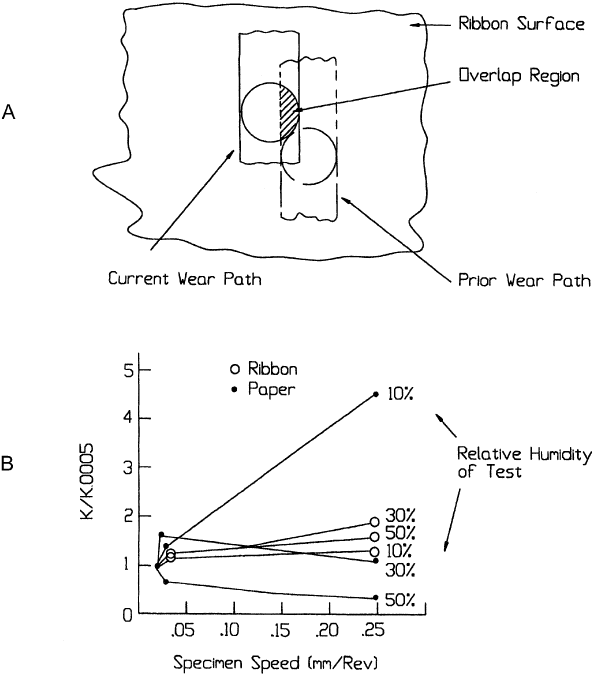
found with a single repeat. Paper surfaces show even larger changes (e.g., an order of mag-
nitude or greater has been observed under some conditions). A major element in control-
ling this effect is selecting the cross-feed speed of the specimen. Depending on the size of
the contact zone, which increases with wear, and the advance per revolution of the drum,
different ratios of virgin to used web surface can occur within the contact zone. This is
illustratedinFig.9.48
. In practice, it is not necessary to completely eliminate the overlap
condition. It is sufficient to determine a cross-feed speed that is large enough so that the
test is insensitive to this effect and to optimize the use of the surface area of the web mate-
rial (e.g., little or no gaps between the wear tracks). The choice is influenced by the sen-
sitivity of the particular material to potential damage, the size of the wear scar typically
produced, and the load. Therefore, value that is used can vary with the type of evaluation
being done. The particular value for the ASTM standar d was selected empirically and
based on such considerations (39).
In general, the selection of the test parameters that can be used in this type of test will
vary with the type of web material being involved. For example, while the values of the
test parameters used in ASTM G56 are appropriate for ribbon, tests with papers have
Figure 9.48 The diagram illustrates the overlap that can occur in the drum test. The graph shows
the effect that this overlap can have on wear. (From Ref. 39.)
Copyright 2004 by Marcel Dekker, Inc. All Rights Reserved.
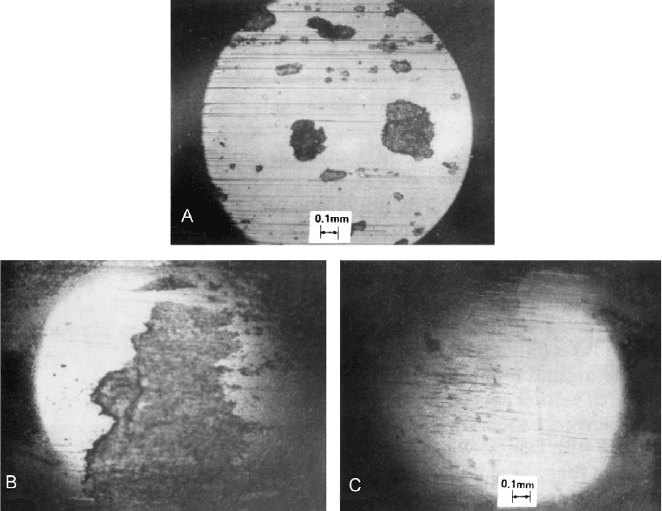
found them to be inappropriate since paper tends to be damaged more easily. In addition,
the accumulation of paper debris in the contact region can alter the wear behavior
significantly. Examples of the distortion in wear behavior that can occur with paper tested
underthewrongconditionswiththistypeofapparatusareshowninFig.9.49
. As a result,
tests at lower speeds and loads but with higher cross-feed speeds are recommended
for papers. In addition, humidity and moisture content have been found to be significant
in tests with paper and these elements have to be controlled as well (44).
In addition to reporting the test parameters with the wear data, any sample prepara-
tion procedures and conditioning should be reported. The temperature and humidity
conditions under which the tests were performed should also be given.
This type of test provides an interesting aspect regarding simulation and illustrates the
latitude that can be associated with simulation when there is sufficient understanding of the
wear situations. The test configuration suggests simulation of applications in which paper
or ribbon slides over a surface or where a component slides over a paper or ribbon surface,
suchasisillustratedinFig.9.50
. Correlations applications of this type have been demon-
strated for this and similar tests (41,43,45,137). In addition to these applications correlation
has also been found with the wear of typefaces in printers, where impact is the predominate
characteristic of the contact (46). Studies have shown that the basic wear mechanism in
such cases is abrasi on as a result of micro-slip between the paper or ribbon surface and
the typeface that occurs during impact. The impact nature of the contact determines the
amount of sliding and the load during the period of contact but does not directly cause
Figure 9.49 Micrographs of worn surfaces produced in drum tests against papers, showing the
build-up of paper wear debris on the surface (‘‘A’’ and ‘‘B’’) and the distortion of the wear scar
as a result of this build-up (C). (From Ref. 39, reprinted with permission from Elsevier Sequoia
S.A.)
Copyright 2004 by Marcel Dekker, Inc. All Rights Reserved.
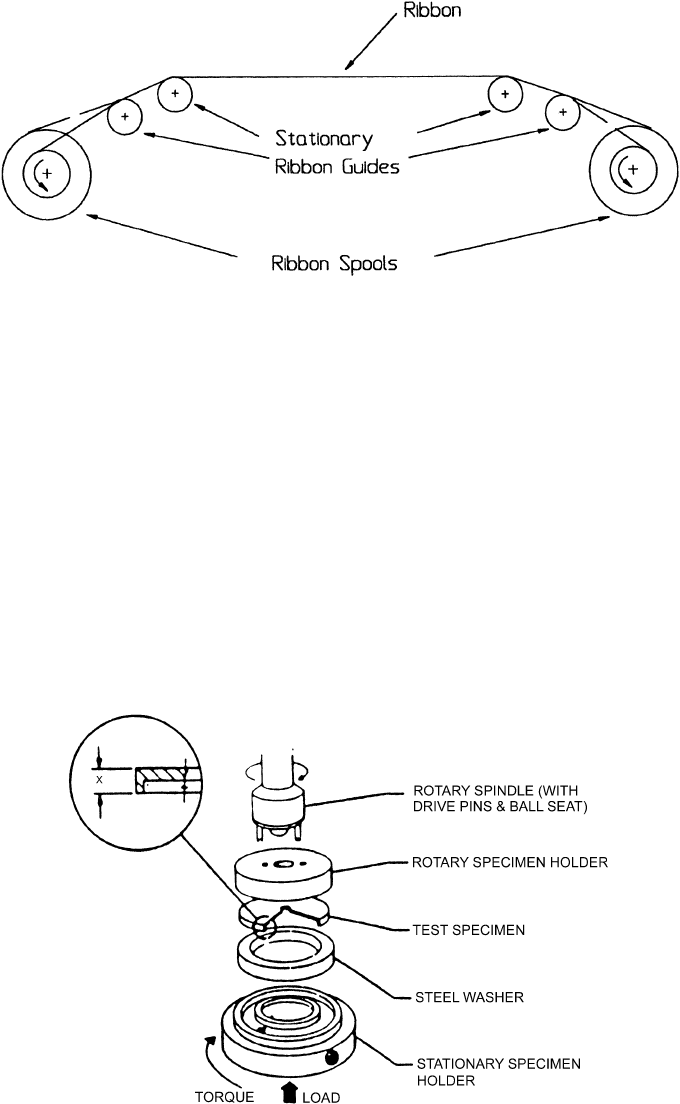
any wear. This wear test is used for these applications to determine an abrasive wear coeffi-
cient for the paper=ribbon-type pair, which is then used in conjunction with an abrasive
impact wear model to predict wear in the application. When the test is used in this fashion,
it provides an acceleration factor that reduces evaluation time by a factor of 10
2
–10
3
.
This illustrates that with increased understanding of the wear situations, it is possible to
develop and utilize tests that focus on intrinsic behavior and are more laboratory-like than
robot-like. Large acceleration factors often can be obtained in these types of approaches.
9.2.13. Thrust Washer Test
The thrust washer test is one that has been used to characterize the stable wear behavior
of plastics sliding against metals surfaces. The basic contact condition of the test is
showninFig.9.51
and is similar to a thrust washer configuration. Generically this type
Figure 9.50 Schematic of a system used to spool ribbon through an impact printer. Wear of the
ribbon guides are a concern.
Figure 9.51 Configuration of the thrust washer test for sliding wear. (From ASTM D3702,
reprinted with permission from ASTM.)
Copyright 2004 by Marcel Dekker, Inc. All Rights Reserved.

of test is different from the other sliding wear tests described in that after a break-in
period the pressure and area of contact remains constant with wear, both surfaces
experience the same amount of rubbing, and the area of co ntact is large. These features
tend to better simulate those associated with many bearing applications for self-lubricat-
ing polymers than the spherical or cylindrical type of contacts used in the other tests.
Since it is not possible to insure perfect alignment of the ring and the plate used in
the test, a break-in period is required to achieve a co nforming contact. During this
break-in period wear data are usually not taken. While this type of test can be per-
formed in a variety of ways and with a variety of conditions and materials, the test
has been used mainly to characterize the wear behavior of self-lubricating materials
(i.e., plastics), against metal surfaces. An ASTM test method, D3702, has been
developed around this test for that purpose.
ASTM D3702 specifies the stationary ring to be made of 1018 steel, hardened to
R
c
20 and have a 16 min. R
a
surface roughness. The plate or rotat ing wafer, as it is called
in the test method, is the polymer specimen. Dimensions and tolerances are specified for
both. The test method allows the use of several combinations of speed and load, which
are representative of the range of PV [pressure (P) times velocity (V)] values that are
found in many applications where plastics are used. A list of those conditions is given
inTable9.3
. Procedures and guidance for cleaning and handling of the specimens are also
provided. In addition, a 40-hr break-in period is specified prior to obtaining wear data.
The break-in load and speed are the same as for the rest of the test. After the break-in
period, the polymer wear specimen is removed and cleaned with a lint-free cloth and initial
thickness measurements made. Then the specimen is remounted, loaded, and the test run
for a predetermined amount of time. At the end of the test, the plastic specimen is again
removed, cleaned with a lint-free cloth, and remeasured. The change in thickness is then
converted to a linear wear rate by dividing the change in thickness by the duration of
the measurement period. This depth wear rate is what is used to characterize the wear
of the self-lubricating material.
The procedure requires the specimen to equilibrate for 1 hr at room conditions prior
to the measurements. The thickness measurements are to be taken at four points, 90
apart, and the average of the four is to be used to determine the wear rate. While a fixed
duration is not specified, it is recommended that it be long enough so that the thickne ss
change exceeds 0.004 in. With a properly built apparatus and proper implementation,
interlaboratory testing has indicated that this test should be repeatable to within 20%.
If scatter beyond this is encountered, some further investigation should be done to
Table 9.3 Combinations of Loads and Velocities Which May Be Used in ASTM D3702
Thrust Washer Test
Loads (lb)
Rotational speed
(rpm)
Rubbing velocity
(ft=min) 1250 2500 5000 10,000
PV (psi-ft=min)
36 10 25 50 100 200
180 50 5 10 20 40
900 250 1 2 4 8
Copyright 2004 by Marcel Dekker, Inc. All Rights Reserved.

determine the reason for it. This should include an examination of the apparatus and
techniques. The interlaboratory testing programs have also shown that an interlaboratory
scatter should not exceed 30% when the same test parameters are used.
While not a requirement with the standard method, it is desirable to include in the
data reported, the particular load and speed used, the ambient conditions of the test,
and adequate descriptions of the materials used, along with cleaning and preparation
techniques. Comments regarding the appearances of the both the wear surface
and the counter-face, both at the end of the break-in period and the end of the test,
are also useful.
The ASTM test method is designed to determine a measure of the stable wear rate of
plastics in the mild wear regime or under the P–V limit for the material. The test method
itself does not provide a measure or determination of the P–V limit. However, by perform-
ing tests at different conditions of load and speed outside of the range specified, the P–V
limit can be determined (47). While the test has been found to be of use in ranking
plastics in terms of general characteristic s, correlation with applications depends on
the degree of simulation between the test and the application and need to be addressed
on a case-by-case basis.
Since the test method limits the counter-face material to a single mate rial and sur-
face condition, the standard test does not provide an absolute measure of wear perfor-
mance. Roughness, as well as composition and hardness of the counter-face are known
to influence the wear rate of plastics (48). Such effects were discussed in the sections on
tribofilmwearandtribosurfaces,3.7and4.3,respectively.
While the standard test
method does not directly provide a measure of absolute wear performance, the format
of the test does have the potential to do so. This is because the basic test method can
be used to determine the coefficient of a wear model. The fundamental modification
of the test method, required for this, would be the use of different counter-face materials
so that actual material pairs and interface conditions could be evaluated. The following
illustrates this use.
The underlying model or wear relationship for this type of use would be the
following:
v ¼ K L S ð9:11Þ
where v is the volume of wear; L, the load; S, the amount of sliding; K, a wear coefficient.
Letting t be time, this equati on can be reduced to the following for a conform ing contact
with constant surface area, A, and sliding at a velocity, V:
v
A
¼ K
L
A
ðV tÞð9:12Þ
h ¼ K ðP VÞt ð9:13Þ
K ¼
h
t
ðP V Þ
1
ð9:14Þ
P is the contact pressure. K in this model would be the wear rate determined in the test,
WR, divided by the PV value used in the test,
K ¼
WR
test
PV
test
ð9:15Þ
Copyright 2004 by Marcel Dekker, Inc. All Rights Reserved.
